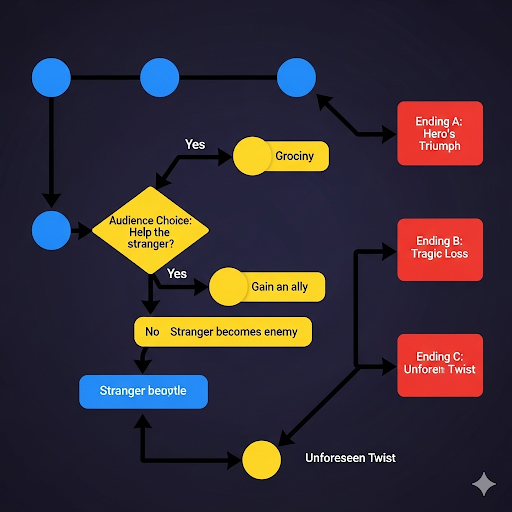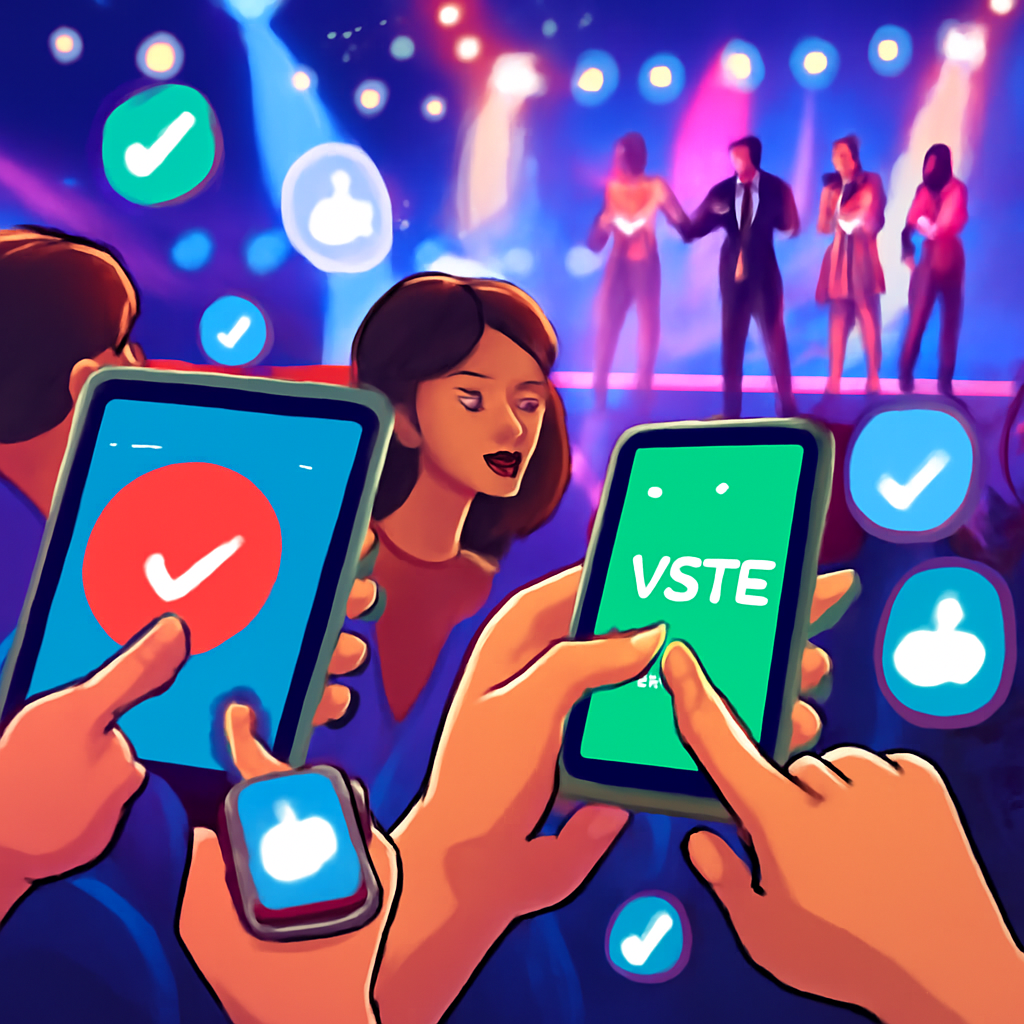Interactive Storytelling: Engaging Audiences Through Viewer Participation
Interactive storytelling transforms audiences from passive viewers into active participants, allowing them to influence narratives through voting, live feedback, and immersive technology, reshaping reality shows, dramas, and live events alike.

In recent years, storytelling in media has undergone a profound transformation. The traditional model, where audiences passively consume content, is giving way to a new, dynamic form of storytelling interactive storytelling. This innovative approach invites viewers not just to watch but to participate, influencing storylines, character choices, and outcomes in real time. Interactive storytelling is reshaping audience engagement by turning viewers into active contributors, creating immersive and personalized experiences that blur the line between creator and consumer.
In this blog, we will explore how interactive storytelling works, why it’s gaining traction, and its diverse applications across reality shows, scripted dramas, and live events. We will also discuss the challenges and opportunities this storytelling model presents, as well as what the future holds for this rapidly evolving entertainment format.
What is Interactive Storytelling?
Interactive storytelling refers to narratives designed to involve the audience in decision-making processes that affect the plot, character development, or event outcomes. Unlike linear stories with fixed endings, interactive stories offer multiple paths and endings, empowering viewers to choose their journey. This engagement can be facilitated through various mechanisms such as voting, live polls, branching narratives, real-time feedback, or immersive technology.
The essence of interactive storytelling is participation giving viewers agency over the story rather than being passive spectators. This participatory approach can take many forms, from simple voting systems in reality TV shows to complex multi-episode narratives where audience decisions shape the story’s direction.
Why Interactive Storytelling is Transforming Viewer Engagement
1. Empowerment and Agency
Modern audiences crave more than just watching; they want to influence. Interactive storytelling gives viewers a sense of control and investment in the narrative. When people can affect outcomes, they feel more connected and emotionally involved, which significantly heightens engagement.
2. Personalized Experiences
Interactive stories often branch into multiple storylines, offering personalized viewing experiences. Audiences can explore characters or themes that resonate with them, making content more meaningful and satisfying.
3. Community Building
Interactive storytelling frequently encourages collective participation, where audiences discuss choices, share theories, and rally around preferred outcomes. This communal aspect fosters social interaction, turning viewing into a shared experience.
4. Extended Content Lifespan
Stories that evolve based on audience input can sustain interest over longer periods. The unpredictability and novelty of outcomes keep viewers coming back, increasing retention and loyalty.
Mechanisms of Interactive Storytelling

Voting and Polls
One of the simplest and most common interactive elements is audience voting. Viewers cast votes to influence key decisions, such as which contestant stays in a reality competition or how a plot twist unfolds. Voting is often live, adding immediacy and excitement.
Branching Narratives
In more complex interactive dramas or series, stories split into multiple branches based on viewer choices. Each decision can lead to different scenes, character fates, or endings, creating a web of possibilities that reward exploration and repeat viewing.
Real-Time Feedback
Some shows incorporate real-time reactions where viewers can respond during live broadcasts through chat, emojis, or polls. This feedback can shape the show’s direction or even how hosts and performers react on-air.
Augmented Reality (AR) and Virtual Reality (VR)
Immersive technologies take interaction further by placing viewers inside the story world. In AR or VR experiences, audiences can explore environments, interact with characters, or make choices in a physically embodied way.
Social Media Integration
Many interactive stories use social media platforms as tools for participation. Fans vote, discuss, and influence storylines through hashtags, polls, and direct engagement with creators, blending storytelling with digital culture.
Applications of Interactive Storytelling
Reality Shows: Harnessing Audience Power
Interactive storytelling has found its earliest and most natural home in reality television. Shows like talent competitions, dating programs, and survival challenges have long invited audiences to vote and influence outcomes.
This model works exceptionally well because reality TV thrives on audience involvement and emotional investment in real people’s stories. Live voting and elimination rounds create suspense and a shared sense of participation. Furthermore, interactive elements allow producers to keep audiences hooked by teasing outcomes and leveraging real-time reactions.
Beyond voting, some reality shows incorporate interactive challenges or audience-driven twists that add unpredictability and freshness to the format. The ability to co-create the narrative helps sustain ratings and deepen fan loyalty.

Scripted Dramas and Series: Narratives That Adapt
Scripted dramas have traditionally been linear, but interactive storytelling is opening new creative doors. Platforms now experiment with “choose-your-own-adventure” formats where viewers decide key plot points.
This approach not only revitalizes storytelling but challenges writers to craft multiple narrative branches that maintain coherence and emotional depth. The success of interactive episodes depends on balancing freedom with narrative satisfaction, ensuring each path offers meaningful consequences.
Interactive dramas encourage binge-watching, as viewers explore alternate endings and character arcs. They also appeal to younger, digitally savvy audiences who expect engagement and personalization in their entertainment.

Live Events and Award Shows: Engaging Audiences in Real-Time
Interactive storytelling isn’t limited to scripted or reality content; it’s also redefining live events and award shows. Audiences can vote for winners, choose performances, or even influence event pacing.
This participation transforms passive viewing into a dynamic experience where fans feel integral to the event’s success. Live polls and social media integration amplify excitement and build anticipation.
Some events incorporate augmented reality layers, enabling viewers to customize how they watch or interact with hosts and performers. This hybridization of live and interactive elements enhances accessibility and broadens appeal.
Case Examples of Interactive Storytelling (Without Mentioning Specific Names)
While we won’t name specific titles, many shows and events have successfully integrated interactive storytelling. Talent competitions have embraced live voting, drama series have experimented with branching episodes, and award shows have involved fans in real-time decision-making. These experiments highlight the versatility of interactive storytelling across formats and genres.
Challenges in Interactive Storytelling
1. Technical Complexity
Designing seamless interactive experiences demands sophisticated technology and infrastructure. Ensuring real-time responsiveness and managing multiple narrative paths can be resource-intensive.
2. Creative Constraints
Writers must balance narrative coherence with audience choice. Too much freedom risks incoherence; too little undermines interactivity. Crafting compelling branches that satisfy viewers requires innovative storytelling techniques.
3. Audience Fatigue
Excessive interaction demands can overwhelm some viewers, who prefer passive consumption. Striking the right level of engagement is crucial to avoid alienating parts of the audience.
4. Measurement of Success
Traditional ratings metrics may not fully capture interactive engagement. New models are needed to evaluate participation, social impact, and viewer satisfaction accurately.
Opportunities and Benefits
Despite challenges, interactive storytelling offers numerous benefits:
- Deeper Emotional Connection: Audience agency strengthens emotional bonds with characters and stories.
- Increased Loyalty: Personalized experiences encourage repeat engagement and long-term fan commitment.
- Expanded Creativity: Writers and creators can explore multiple narrative possibilities and innovative formats.
- Community Growth: Shared decision-making fosters vibrant fan communities and social engagement.
- Revenue Potential: Interactive elements open new monetization avenues such as pay-per-choice models or exclusive content.
The Future of Interactive Storytelling
The future promises even more immersive and sophisticated interactive storytelling experiences. Emerging technologies like artificial intelligence could tailor stories dynamically to individual preferences in real-time. Advances in VR and AR will blur the lines between gaming and traditional storytelling, creating fully immersive worlds where narratives evolve with each participant’s actions.
Hybrid formats combining live and pre-recorded content, social media, and immersive tech will become mainstream. Interactive storytelling will increasingly cater to diverse audience segments, offering tailored experiences that reflect cultural, social, and emotional nuances.
Creators will collaborate more with their audiences, co-creating stories that reflect collective imaginations and values. As storytelling becomes a shared journey, the entertainment industry will be reshaped around participation, connection, and innovation.
Conclusion
Interactive storytelling marks a paradigm shift in media consumption, transforming viewers from passive observers into active participants. By empowering audiences to influence narratives through voting, real-time feedback, and immersive technology, interactive storytelling deepens engagement, fosters community, and expands creative horizons.
From reality shows to scripted dramas and live events, this approach offers exciting new ways to connect with audiences and tell compelling stories. Though challenges exist, the opportunities for innovation, personalization, and emotional resonance are immense.
As technology evolves and audience expectations rise, interactive storytelling will continue to redefine the entertainment landscape, inviting us all to become co-authors of the stories we love.




